Benefits and Mechanics of Foil Boards for Kiteboarding
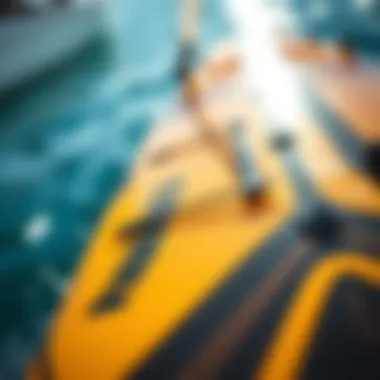
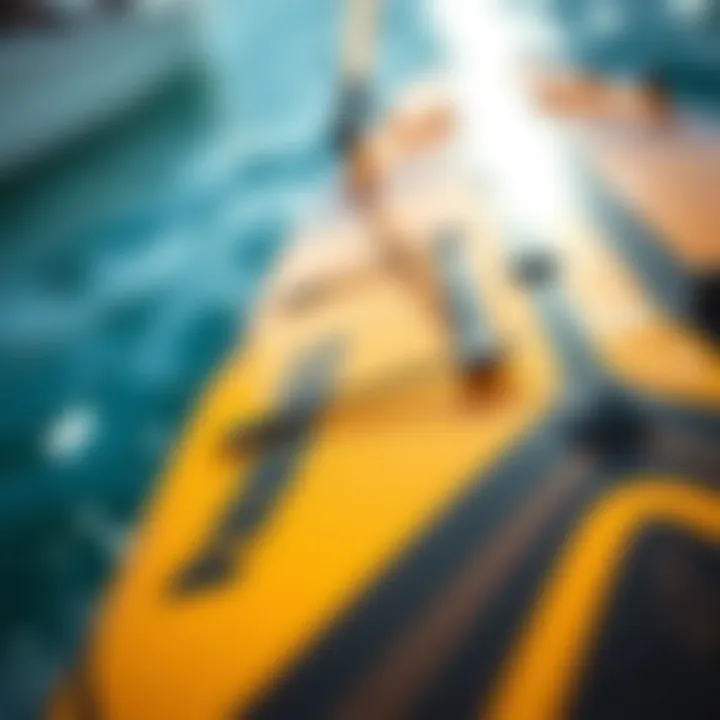
Intro
In the realm of water sports, few innovations have stirred excitement like the foil board. Designed for performance and agility, a foil board allows kiteboarders to glide above the water's surface, creating an exhilarating feeling of flight. As this sport continues to gain traction, understanding how to utilize a foil board behind a boat becomes crucial for both novices and seasoned enthusiasts alike.
The science behind a foil board’s mechanics is quite fascinating, involving principles of hydrodynamics that enable it to rise above the water at certain speeds. This article aims to peel back the layers of what makes a foil board tick, delving into its multifaceted benefits while also addressing the considerations that come with it. We cater to various kiteboarding enthusiasts, focusing on gear, techniques, performance factors, and safety measures that would not only enhance one’s skills but also maximize enjoyment in varied water environments.
Now, let’s dive headfirst into the essentials that could make your kiteboarding experience not just fun but also rewarding.
Understanding the Foil Board
Foil boards represent an exciting shift in water sports, bringing an innovative approach to riding behind a boat. They allow riders to glide above the water instead of skimming along its surface. This transformation opens up unique possibilities for those who wish to elevate their experience on the water. By understanding the function and intricacies of a foil board, one can fully appreciate its range of benefits and what it brings to the table for kiteboarding enthusiasts and adventurers alike.
Definition and Overview
A foil board is a specialized type of board equipped with a hydrofoil underneath, which consists of a wing-like structure that generates lift as it moves through the water. The lift raises the board above the water, allowing for a smoother ride and reduced drag. This dynamic enables riders to experience increased speeds while minimizing contact with the waves. Ultimately, understanding this definition sets the stage for recognizing the exhilarating appeal of foiling in various water conditions.
Components of a Foil Board
Board structure
The structure of a foil board is pivotal to its performance. Typically longer and wider than traditional boards, it is designed to provide stability as the rider lifts off the water. A key characteristic of this structure is its lightweight construction, often made from materials like carbon fiber or foam, which minimizes weight without sacrificing strength. This construction style makes it a popular choice among those pursuing high-performance riding. Unique to the board's design are the concave shapes, which help manage water flow and enhance lift during takeoff, offering distinct advantages over conventional boards. However, some riders might find the larger surface area may require adjustment to their riding style.
Foil assembly
The foil assembly essentially comprises the mast, wings, and fuselage, which are crucial for generating lift. The mast connects the board to the wings, which are angled to optimize lift while minimizing drag. A distinctive feature of foil assembly is its versatility, allowing riders to customize their setup based on skill level and riding style. This adaptability makes it appealing for everyone from newcomers to experienced foilers. However, the complexity of assembling and fine-tuning a foil setup can be seen as a drawback for beginners, who might find it less intuitive compared to traditional kiteboarding systems.
Comparison with Traditional Boards
Hydrodynamics
When comparing the hydrodynamics of foil boards with traditional boards, the difference in water interaction is stark. While traditional boards create drag due to their full water contact, foil boards reduce drag significantly by lifting above the water's surface. This key characteristic allows for faster speeds and more efficient energy use, making foil boards a desirable choice for serious kiteboarders. The unique advantage here lies in the ability to cut through choppy waters with relative ease, which can enhance overall performance.
Performance differences
The performance differences between foil boards and traditional boards can be summarized in terms of speed, efficiency, and ride quality. Foil boards can achieve higher speeds with less effort, offering a sensation akin to flying over the water. While traditional boards might require more physical effort to maintain speed, foil boards enable a smoother ride, which is particularly advantageous during longer sessions. Nevertheless, the learning curve associated with mastering a foil board can be steeper, as it involves adapting to the sensation of being lifted above the water, something traditional boards do not demand.
"The lift and glide of foil boards offer a captivating ride that fundamentally alters the approach to water sports."
Why Use a Foil Board Behind a Boat
Utilizing a foil board behind a boat can drastically enhance your water sports experience. Foil boards elevate the rider above the water surface, which diminishes resistance and allows for unique maneuvers. This innovation isn't just for show; it carries significant implications for performance and enjoyment.
The Mechanics of Foiling
To understand why foil boards are effective behind boats, one must first grasp the mechanics involved.
Lift generation
Lift generation is pivotal in foiling. When a rider accelerates, the foil's shape interacts with water in such a way that it creates upward force, lifting the board and rider above the surface. This dynamic lift is crucial; it transitions riding from the traditional method of direct contact with water to a suspended form that changes the riding experience. The distinctive shape of foils encourages a unique airflow, which can enhance the lift significantly under certain conditions. However, achieving the ideal lift can require a level of skill and practice that may be intimidating for beginners. This aspect makes foil boarding both thrilling and challenging.
Drag reduction
The main characteristic of drag reduction lies in its efficiency. With less surface area in contact with water, foil boards experience less resistance, allowing speed to increase dramatically. This quality is a huge draw for those looking to improve their performance on the water. However, a greater awareness of water conditions is essential; significant wave actions can induce drag that can negate the benefits of using a foil board. This aspect of foiling makes understanding the environment critical for anyone looking to get the most out of the experience.
Advantages of Foil Boards
Foil boards come with several advantages that appeal greatly to water enthusiasts.
Increased speed
One major advantage of foil boards is their ability to achieve higher speeds with less effort. Traditional boards can become sluggish, especially in choppy water. Foil boards, however, carry the rider's weight above the resistance, enhancing their speed potential significantly. The thrill of slicing through water with minimal resistance is a prime appeal. Yet, it's worth noting that speed also demands more focus and control, which may pose challenges for some riders.
Smoother ride

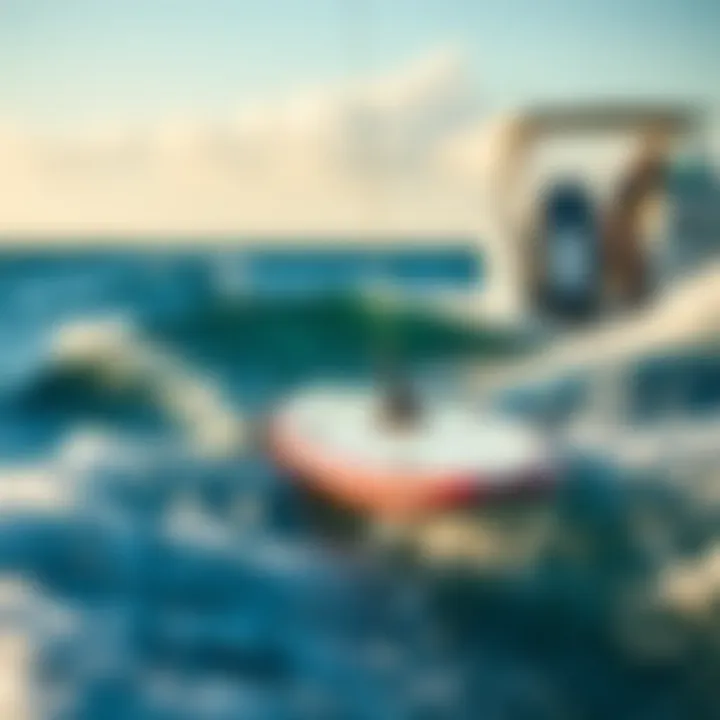
The smoothness of the ride is another highlight. Riding on a foil board means you glide over the surface, reducing the bouncing and jarring effects of choppy water. This feature transforms the experience into one that feels more fluid and natural, enhancing overall enjoyment. Still, achieving a consistently smooth ride requires practice and can be affected by water conditions and riding techniques.
Ideal Conditions for Riding
Understanding when and where to ride on a foil board is vital to maximizing the experience.
Water surface conditions
Calm water is a friend to foil boarders. Flat and smooth surfaces boost the lift characteristics of the foil, allowing for cleaner rides and improved control. However, in rough waters, the very conditions that can lead to excitement also pose risks; the potential for losing control increases. Therefore, ideal conditions align closely with the rider's ability to gauge their surroundings.
Wind impact
Wind plays a significant role in foiling. A gentle breeze can be a catalyst for motion, lending itself to a more dynamic ride. Nonetheless, strong winds can create obstacles by altering the power and direction of your ride. Understanding wind patterns is crucial for navigating effectively and stays safe on a foil board.
In summary, diving into foiling requires not only skill and zest but also knowledge about mechanics and environmental conditions. Each of these elements contributes to a comprehensive understanding of why using a foil board behind a boat is becoming a popular choice among water sports enthusiasts.
Selecting the Right Boat for Foiling
Choosing the right boat to pair with a foil board is essential for maximizing the foiling experience. The boat's characteristics significantly influence how well the foil performs. Not all vessels are made equal, and without the right match, both safety and enjoyment can take a hit. This section outlines key elements to consider when selecting a boat for foiling, ensuring both optimum performance and a smooth ride.
Boat Type Considerations
Powerboats vs. Sailboats
One of the primary choices facing enthusiasts is the decision between a powerboat and a sailboat. When it comes to foiling, many find that powerboats are often more suitable. The main reason for this inclination is the consistency of the wake produced by powerboats, which is typically more stable and larger compared to that generated by sailboats.
This stability is a crucial factor because it allows for easier take-offs and landings while foiling. Moreover, powerboats can generate enough speed quickly, achieving the necessary lift without excessive effort. In contrast, sailboats, despite their romantic allure on open waters, may not provide the same reliable conditions for foiling, making them less favorable for serious kiteboarders.
On the other hand, sailboats can offer a unique experience when foiling, especially for those who appreciate the skill involved in combining sailing and kiteboarding. The challenge can be enticing, and while the learning curve is steeper, many seasoned enthusiasts find it rewarding.
Size and Weight Considerations
When it comes to size and weight, boat specifications play a crucial role in foil boarding. Ideally, a boat should strike a balance between being large enough to create a substantial wake while remaining lightweight enough for maneuverability. A heavier vessel may be stable in rough waters but can struggle to gain speed quickly, which is vital for lifting the foil off the water surface.
Conversely, a smaller, lighter boat could help achieve necessary speeds, but its ability to produce a more substantial wake may be compromised. Additionally, the distribution of weight onboard must be considered, as improper balance can lead to complications while foiling, affecting the overall ride quality.
Gear Compatibility
Foil Board Specs
The specs of your foil board are another paramount consideration when pairing it with a boat. The dimensions and weight capacity of the foil board must align with what the boat can handle. For instance, a larger board often requires a boat that can accommodate a significant load, while lighter options may be more versatile but could compromise on sturdiness in rough conditions. Also, specific features of the board — like its shape and volume — can influence performance.
One key point here is the compatibility between the board and the given boat. A well-matched setup can greatly enhance the foiling experience, allowing riders to optimize lift and decrease drag effectively.
Boat Wake Considerations
When considering the boat's wake, you want to think about how it interacts with the foil. Ideally, a boat should create a clean and defined wake, which is essential for effective foiling. This feature significantly impacts lift and handling while riding the foil.
Boats that provide erratic wake patterns or turbulence can hinder performance, lead to difficulty in maintaining lift, and result in a bumpy ride. A particular boat might excel in creating a stable wake at higher speeds, making it perfect for foiling enthusiasts searching for that smooth, gliding sensation.
"A well-chosen boat is like finding the right dance partner; it can lead to a stunning performance on the water."
Ultimately, thinking through these considerations will help enthusiasts select the right boat that not only enhances their foiling experience but also ensures safety and sustainability in their kiteboarding adventures.
For more information on different types of boats, you can check out websites like Wikipedia or Britannica. Also, forums like Reddit and groups on Facebook can offer insight and community perspectives.
Techniques for Effective Foiling
When you head out on the water with a foil board, it’s not just about having the right gear. It requires a certain finesse and understanding of the techniques involved. Mastering these techniques ensures that riders can maximize the potential of the foil board, transforming their experience into something exhilarating. From mounting the board correctly to controlling the hover, every aspect plays a crucial role in achieving a smooth and effective ride.
Mounting the Foil Board
Positioning
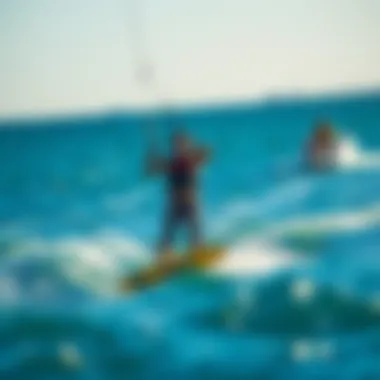
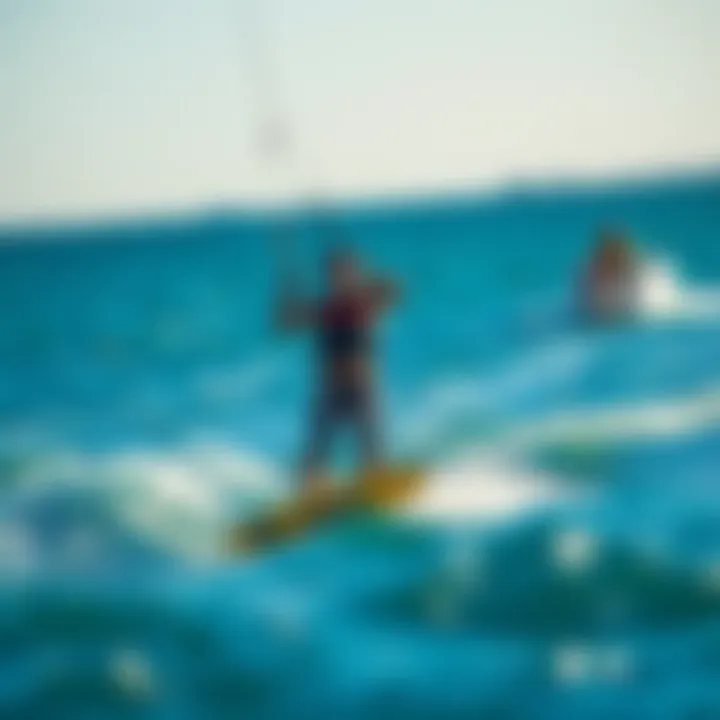
Positioning of the foil board is a fundamental aspect that cannot be overlooked. The goal is to ensure that the board is aligned in such a way that it optimizes its performance on the water. Generally, placing the foil further forward can help in achieving early lift-off, allowing riders to get up and skating quickly.
One notable characteristic of this positioning is its adaptability. Whether you're a beginner or an advanced rider, adjusting your positioning can significantly change how quickly you get up from the water. A forward position often allows for better control in various water conditions, making it a popular choice among enthusiasts. However, going too far forward could lead to a nose dive, which is certainly not the goal. The unique feature of this technique is its ability to be fine-tuned based on the rider's weight and skill level, balancing that fine line between lift and control.
Balancing Weight
Balancing weight is another critical technique that bears strong emphasis. Essentially, where your weight is distributed on the board will determine how the foil interacts with the water. For optimal foiling, keeping your weight over the front foot helps to maintain lift and avoid stalling out.
The main characteristic of weight balancing is its impact on stability. A well-balanced approach enables smoother transitions and maintains a steady ride. It's a technique that is beneficial as it empowers the rider; by shifting weight slightly back or forward, one can fine-tune the board's response to the water surface. However, over-compensating can throw the rider off balance completely. In this article, understanding the nuances of weight balancing helps in preventing unwanted crashes and maximizing ride quality.
Controlling the Hover
Body Positioning
Effective body positioning is key to mastering the hover while foiling. Good body alignment, with knees slightly bent and a straight back, contributes to better control and stability in the air. Leaning slightly forward can increase the lift, while a more relaxed posture might lower the elevation.
The standout feature of body positioning is how it directly affects the rider's control. A proper stance allows riders to be responsive to shifts in the wind and water currents. This technique is not merely beneficial; it is essential for advanced maneuvers and tricks. Too often, riders underestimate the significance of body positioning and become destabilized, losing the hover they worked so hard to achieve.
Weight Transfer
Weight transfer plays a crucial role in controlling the hover effectively. By transferring weight wisely between feet, riders can adjust their elevation and manage the control of the foil board during maneuvers. This action impacts how the foil engages with the water.
The defining characteristic of weight transfer is its immediacy in changing the dynamics of a ride. It becomes a means to navigate through waves and adjust height with fluidity. This technique is extremely advantageous when it comes to handling varying sea conditions. Just a small shift can mean the difference between a perfect glide and an abrupt crash.
In summary, understanding and practicing techniques for effective foiling is essential for any rider looking to optimize their experience with a foil board behind a boat. Each of these elements works cohesively, allowing for better control, stability, and enjoyment on the water. By focusing on mounting techniques, body positioning, and weight transfer, kiteboarders can elevate their skills to a whole new level.
Safety Considerations While Foiling
When engaging in the exhilarating experience of foiling behind a boat, prioritizing safety can’t be overstated. A foil board provides not just thrills, but also brings certain risks that require attention. Awareness and preparation can make a world of difference between a memorable outing and an avoidably harrowing experience. Let's explore key aspects to keep in mind.
Safety Gear Recommendations
Heads Up Display (HUD)
A Heads Up Display (HUD) is quickly becoming essential for many kiteboarders. This device projects vital information directly into your line of sight. Imagine being able to track speed, altitude, and direction without taking your eyes off the surroundings— that’s the beauty of a HUD. Its integration into the foiling experience enhances situational awareness, which is paramount when navigating waters where sudden changes in conditions can occur.
One standout feature is the instant access to data, giving riders the confidence to push their limits with a clear view of performance metrics. However, it can become a double-edged sword; if not calibrated properly, a HUD may show inaccurate readings, which could mislead a rider. Proper training on how to interpret the data is crucial.
Protective Wear
Before hitting the waters, there's no reason to skimp on protective wear. Vests, impact shorts, and even helmets can be lifesavers. Their primary role is obvious: to shield against falls and impacts when you're trying to master those thrilling tricks or just enjoying a smooth gliding session.
A significant characteristic of protective wear is its comfort level. Many enthusiasts prefer stylish designs that don’t restrict movement. Some gear even comes equipped with floatation devices, enhancing safety further. On the downside, it can feel hot and cumbersome during long sessions under the sun, but the benefits far outweigh these inconveniences.
Emergency Protocols
Reboard Procedures
Knowing how to safely reboard your foil board after a tumble is a skill every rider should have sharp in their toolkit. This procedure involves not just physical techniques, but also mental preparedness. Understanding where to position yourself on the board to regain balance can save precious moments during emergencies.
What sets a good reboarding procedure apart is its clear steps: assess the surroundings, ensure the boat is at a safe distance, and be methodical in returning to your board without causing injury. However, it’s sometimes easy to underestimate the importance of calmness during reboarding—panic can lead to further mishaps. Simple drills can help solidify reboarding skills, turning a chaotic moment into a seamless maneuver.
Signal Devices
Signal devices are crucial for ensuring others can locate you in case of an emergency. When foiling, especially in open waters, visibility can be a challenge, and having a reliable signaling method can be a lifesaver. Devices range from waterproof whistles to floating signal flags that draw attention.
When choosing a signal device, consider its portability and durability. A lightweight, compact device that doesn’t impede your performance but can be easily accessible when you need it, is a fine choice. That said, some high-tech options such as GPS trackers or emergency beacons can offer added peace of mind. Their drawback, however, is the dependency on battery life and proper maintenance. Knowing how to use these devices well can turn an emergency into a minor inconvenience, so embrace this technology but with an understanding of its limitations.
Maintenance and Care for Foil Boards
Maintaining a foil board isn’t just a chore; it’s essential for ensuring long-term performance and safety. The conditions under which these boards operate can be intensive. Water sports enthusiasts know that saltwater or fresh water can both take their toll. Keeping your board in top shape helps maintain the impressive lift and speed it offers. Proper care translates directly to better experiences on the water and potentially more time enjoying yourself without unexpected repairs.
Materials and Durability
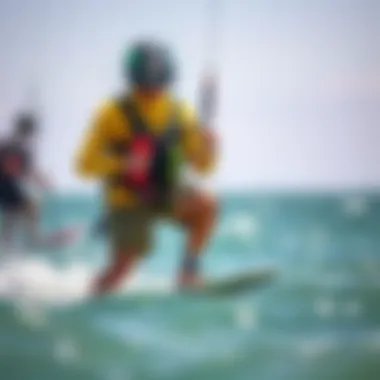
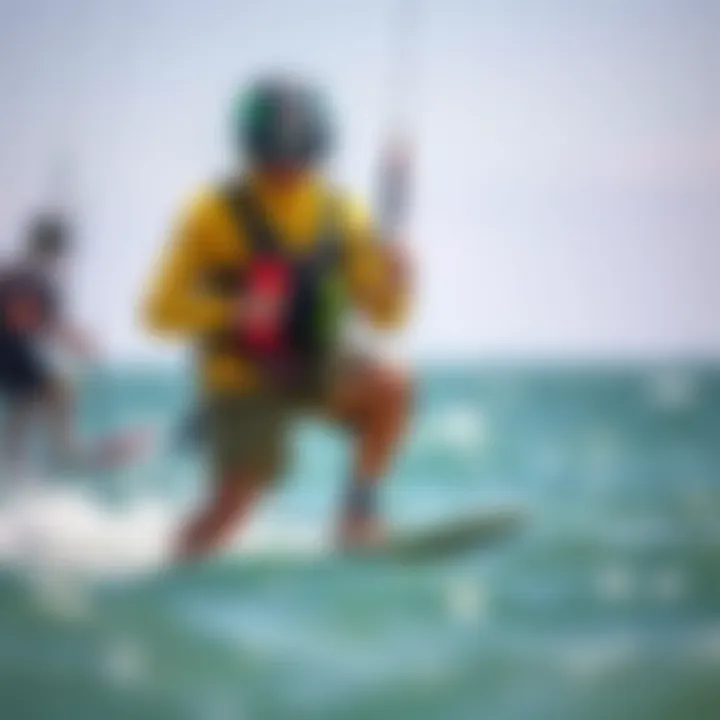
Common materials used
Foil boards are typically crafted from a variety of materials that emphasize strength-to-weight ratios. Carbon fiber, for instance, reigns as a heavyweight champion in the world of materials. Known for its rigidity and lightweight nature, carbon fiber provides superior performance by reducing drag when gliding. It makes the board not only robust but also agile enough for sharp turns and quick responses.
Another common choice is fiberglass, which offers a balance between cost and performance. While slightly heavier, fiberglass can withstand impacts and is often more forgiving than its carbon counterparts. This characteristic might make it a favorable option for beginners who may have less control.
Ultimately, while materials play a vital role in the longevity and durability of the board, understanding the benefits and trade-offs associated with each type is crucial for maximizing your foiling experience.
Long-term care
As for long-term care, it’s about fostering a relationship with the board and using it efficiently. This means not just using your board, but also ensuring it gets enough rest. Regular checks for signs of wear and tear – especially around the joints and foil assembly, can make a significant difference in the lifespan of the equipment.
Additionally, it’s wise to avoid exposing the foil board to harsh environments, like extreme heat or prolonged sunshine, as these can warp or degrade the materials. Proper storage—such as keeping it in a dry, shaded area—can prevent potential damage. Long-term care is not just about the durability of the board but ensuring that it remains a trusty companion every time you hit the water.
Cleaning and Storage Tips
Post-ride maintenance
After enjoying the swells, it’s crucial to give your foil board a little TLC. Rinsing off saltwater or dirt with fresh water is highly recommended. Failing to clean after use is a surefire way to invite corrosion and weaken the components over time. You’ll want to focus on areas where dirt accumulates—around the foil assembly and edges, where grime tends to cling. Regular post-ride maintenance not only prolongs the life of your board but ensures that every ride is as exciting as the last.
Storage conditions
Once the day’s adventures are over, how and where you store your foil board matters immensely. Keeping the board in a temperature-controlled environment is ideal. If that’s not an option, consider investing in a board bag that offers extra padding and protection. Avoid stuffing it in areas where the pressure could warp the structure, like a tight garage or under heavy objects.
Moreover, it is beneficial to store it away from direct sunlight. Sun exposure often fades colors and weakens materials, particularly in fiberglass boards. A cool, dark place with sufficient support for the board can help it keep its shape longer. Understanding these storage conditions is critical for ensuring that your gear remains performance-ready.
Proper maintenance and care are the pillars on which your foiling adventures stand; neglect can lead to disaster.
The Future of Foil Boarding
The future of foil boarding looks promising and is rapidly evolving, influenced by advancements in technology, design, and a growing community of enthusiasts. The combination of innovation and increased interest among sports enthusiasts signals a shift in how we understand and utilize foil boards for various water sports. As both materials and designs become more refined, there’s an exciting trajectory where performance and environmental considerations come together, creating a more rich experience for riders.
Technological Advances
New materials
The advent of new materials in the construction of foil boards is one of the key factors driving their evolution. These materials, often lightweight yet strong, offer improved performance and durability. For example, advancements in carbon fiber and specialized composites enhance the responsiveness and rigidity of the boards.
The key characteristic of these new materials is their ability to maintain structural integrity while shedding excess weight. This is crucial as it allows for easier maneuverability and faster speeds, benefiting not only professionals but also casual riders looking to enjoy their time on the water. Lightweight yet durable is how one might sum up the value of these materials.
Advantages come aplenty; less weight means improved lift and reduced drag, translating to a more efficient ride. A downside, however, can be the cost associated with these high-end materials, which may put them out of reach for novice riders. Still, those who invest will likely see a return in performance and enjoyment.
Enhanced designs
In addition to materials, enhanced designs play a pivotal role in shaping the future of foil boarding. Manufacturers are continuously working to create more hydrodynamic profiles and optimized foil shapes that allow for smoother cutting through water. These designs significantly contribute to lift generation and speed.
A prime characteristic of enhanced designs is their focus on user customization. Riders can now select foils with varying aspect ratios and widths, tailoring their ride to personal preferences and conditions. This customization enhances versatility, making it easier to adapt to varying water types or skill levels. The unique feature here is that with the right setup, a rider can maximize their experience, whether cruising on calm waters or tackling rough waves.
The benefits are clear, offering greater stability and control. However, one must keep in mind that the complexity of choice and settings can overwhelm new riders; a learning curve exists as they navigate these advanced configurations.
Growing Popularity and Trends
Community engagement
The increasing community engagement is another aspect that contributes to the bright future of foil boarding. As more people take to social media platforms and forums, they share tips, experiences, and even challenges related to foil boarding. This engagement fosters a sense of belonging and support.
The key characteristic here is shared knowledge. Community engagement serves as a platform for novice riders to learn from experts, making the sport more accessible. Connecting with fellow enthusiasts encourages participation and inspires individuals to improve their skills, creating a vibrant ecosystem around foil boarding. As riders exchange tips and showcase their experiences, the popularity of the sport continues to swell.
This dynamic enhances both enjoyment and educational opportunities; however, it can also introduce a competitive edge that might be daunting to some beginners.
Event participation
Event participation is growing as well, providing riders with opportunities to showcase their skills and partake in friendly competition. Participation in foil boarding events helps to bring the community together, encouraging anyone interested in water sports to join in the fun.
The special aspect of these events is their ability to promote camaraderie and collaboration among participants. They not only serve as a platform for competition but also help in spreading awareness about foil boarding, drawing interest from onlookers who may be inspired to give it a try. Being at these events can provide firsthand knowledge and techniques from some of the best in the industry.
While event participation brings many advantages, it also brings pressure, as participants often feel the need to perform well. Striking a balance between serious competition and enjoyment can be the key to a positive experience.
As we look to the horizon, it’s clear that the future of foil boarding holds much promise. With technological advancements paving the way and a growing community encouraging participation, enthusiasts can expect a vibrant and ever-evolving sport that continues to captivate passionate riders.



